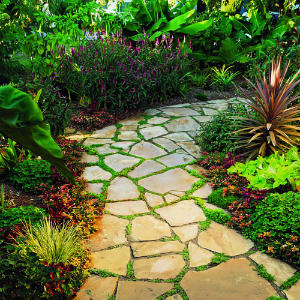How to Design a Garden Path

A beautiful path can greatly enhance the appearance and feel of any garden. If you design a functional garden path, it can serve as a walkway and keep shoes from getting dirty. Likewise, a creatively done garden path can serve as an inspiration and display of your esthetic sense. Either way, there are many benefits of making a garden path and you should keep reading this article to find out how to make it.
Things Required:
– Paving Materials (large stones, concrete pavers or cut stones)
– Landscape Fabric
– Gravel
– Sand
– Edging (steel, aluminum or masonry)
Instructions
-
1
Overall design
Create the overall design you want for your garden path. Keep things simple and walk around your garden to mark different areas that you enjoy. If you have beautiful trees or flowers, then design your path around them or have it curve and turn around the garden. While a straight route is the most efficient, you can make a varied, twisting and turning route to make sure the person walking on it gets to see all the beautiful flowers and trees in your garden. Make sure to design the width of your garden path to either accommodate two people or a single person depending on your requirements and availability of space. -
2
Choose material for paving
It is very important to choose the right material for paving your garden path. There are many different materials available, like cut stones, concrete pavers, large stones and poured concrete. Visit a home improvement store to check out these materials up close and get a good idea of what they look like. Make sure to choose a material that is not slippery, as gardens can get wet due to dew and you do not want anybody to get hurt on your garden path. Go online or visit other gardens to get an idea of the different materials that are currently available. -
3
Proper drainage
While designing a garden path it is important to account for proper drainage. Any stagnant water on your garden path will attract insects and create an unhealthy pool. Make sure that your garden path has a slight slope to encourage drainage. You can do this by making the entire path about ½ inch higher than the surrounding area or 1 degree (1/8 inch) of the length and 2 degrees (1/4 inch) of the width per foot. -
4
Make gravel base
Make a gravel base that will hold the pavers level. Keep in mind that if the area where you live freezes, you should make the base up to 8 inches deep. If the ground does not freeze in your area then make the depth of the base around 4 inches. Once you make your gravel base, do not forget to add some leveling sand (around 2 inches deep) so that you can easily move the pavers in to place. You can also put landscaping fabric over the gravel to prevent weeds from growing in your path. -
5
Secure pavers
In order to properly hold the pavers in place, use edgings made out of aluminum, masonry or steel. It is entirely up to you which material you use for your edging.




